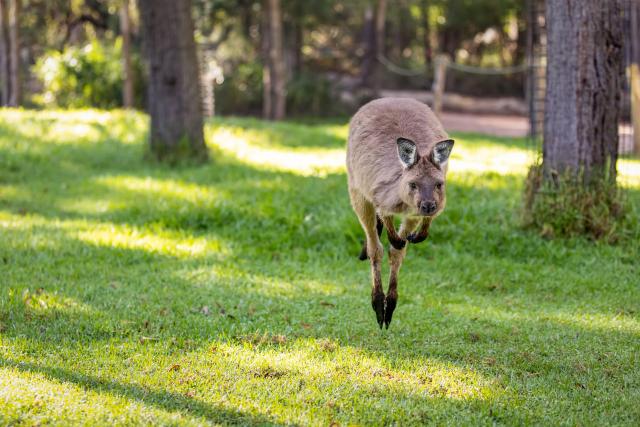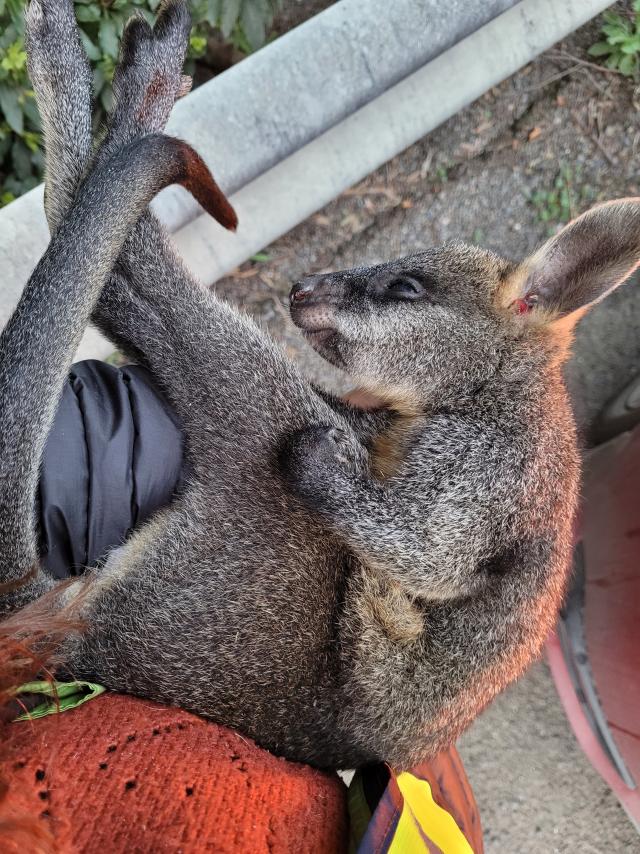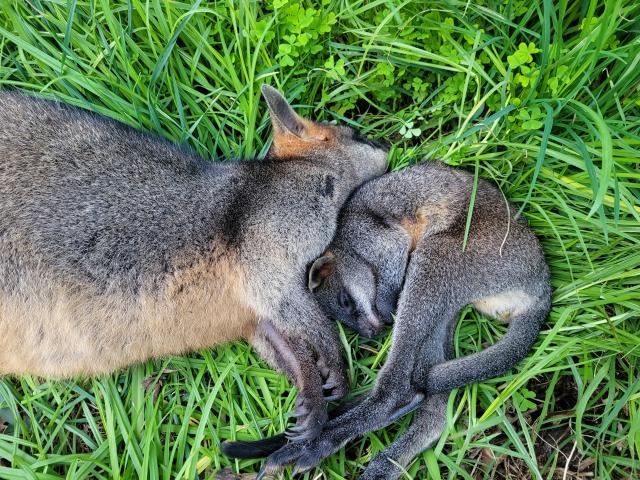
By Tyler Wright
WARNING: DISTRESSING CONTENT AND IMAGES ARE FEATURED IN THIS ARTICLE
A local wildlife rescuer is calling for more community and government body awareness after recent animal casualties along Wellington Road.
On Wednesday 12 July, Emerald-Monbulk Wildlife Shelter volunteer Leanne Sultana said she conducted three pouch checks on animals that had been left on the side of the road on her way from Emerald through Rowville to her work at Monash University.
“The stretch of road is a horrible road for wildlife getting killed,” Ms Sultana said.
After finding a large kangaroo in the middle of the road near the Cardinia Reservoir, followed by pouch-checking a “badly mangled” wombat in Clematis, it was coming across a dead wallaby joey before the Lysterfield BP that left Ms Sultana “heartbroken”.
“I had her body in the palms of my hand, she was just tiny,” she said.
“I noticed that she had some blood in her ear so she probably would have had some kind of head trauma. But the fact that she had just passed away by the time I had gotten to her was the thing that absolutely devastated me.”
The joey’s mother had already been dead for what Ms Sultana estimated was a couple of hours prior, and was lying on a nearby roadside barrier nearby.
“Her joey was basically left on the road to die.”
Wildlife Victoria has received an average of nine calls per month from members of the public reporting wildlife hit by vehicles on Wellington Road between Rowville and Emerald/Clematis, a spokesperson from the organisation said.
“71 per cent of the wildlife hit by vehicles on that stretch of road in the past six months were kangaroos. Other wildlife species impacted on Wellington Road are wallabies, wombats and echidnas,” the spokesperson said.
“Wildlife Victoria receives approximately 110,000 calls each year from members of the public reporting sick, injured, or orphaned wildlife.
“Unfortunately, the greatest cause of injury to wildlife is road-related accidents with thousands of native animals killed or injured on Victoria’s roads each year.”
The spokesperson said between 2019 and 2020 on Wellington Road, there was a “48 per cent decrease” in wildlife road-related incidents.
“This trend over the Covid lockdown period shows how prevalent wildlife road trauma is.
“Wildlife Victoria engages with local councils regularly to provide advice and share insight into how they can reduce the wildlife road toll. We are seeing more and more councils acknowledge the importance of wildlife and biodiversity within their municipality, with many taking action to ensure the protection of wildlife for future generations.”
Ms Sultana said more awareness needs to be put out to communities, councils and government bodies.
“I’ve had enough of doing this, because I do this every single time I drive to work,” she said.
“There is hardly a day that I don’t stop to do a pouch check or to check on an animal to see if they’re alive, or dragging an animal off the road.
“It’s gone to the point where this is winter – we shouldn’t be seeing so many road deaths on the road – so once spring [comes]…we’re going to be seeing more and more fatalities on the road.”
Ms Sultana said reducing speed limits along Wellington Road may help reduce the impact of wildlife vehicle trauma, but acknowledged that it would be a “hard pitch” for the community.
“80 kilometres is still too fast because all the animals are getting hit in the 80 zones,” she said.
“If that was supposed to go down to 60, and the hundreds to 80, it will actually add on seven minutes to everyone’s commute…in a way, we’re saying ‘well, are people really willing to drive the extra seven minutes to save the fatalities or to reduce the fatalities of an animal?”
Ms Sultana said she has tried to contact the Department of Transport and Planning and councils to advocate for fencing to be installed along the 21-kilometre stretch of road, but has not had a response.
“It’s been a cause of frustration.
“It’s not even an animal problem, it’s a human problem because this is incredibly dangerous for motorists…people who try to swerve to not hit an animal, it’s dangerous all in all,” she said.
A Department of Transport and Planning spokesperson said preventing collisions with animals is an ongoing challenge as wildlife can be “unpredictable,” and enter roads at “any time regardless of roadside conditions”.
“We encourage all motorists to travel at safe speeds, leave plenty of space between them and the car in front and take extra care when animals may be on the move, particularly at dawn and dusk,” the spokesperson said.
Cardinia Shire Council’s manager of community infrastructure, David Fice, said the body is committed to the “preservation of our widlife through actively advocating for under-road culverts and wildlife barrier fencing”.
“We are also trialling bandicoot crossings and wildlife sensitive lighting on some of our roads,” Mr Fice said.
“For more information go to www.cardinia.vic.gov.au/sustainableroads.”
If a motorist does hit wildlife, they are advised to pull over when safe to do so and call Wildlife Victoria’s Emergency Response Service on 03 8400 7300.
“The phone line is staffed by trained wildlife emergency operators 24/7 who can provide expert advice,” the Wildlife Victoria spokesperson said.
“If the animal is a marsupial, and its deceased, they may direct the member of the public to check its pouch for young.
“In-pouch joeys can survive up to two weeks in their mother’s pouch after she has passed so it’s vitally important pouches are checked. It might just save a life.”








